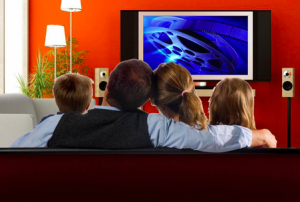For some people, creating a “home theater” means simply mounting a large flatscreen on the wall and calling it a day. They might add an external speaker or two later, but the setup still feels more like a living room with a big TV than an immersive entertainment experience.
If you’re aiming for a true theater-like experience with your home theater—one that brings the excitement of the big screen right into your living room—then you’ll need to take a more thoughtful approach. Designing a home theater goes beyond just the TV; it’s about creating an environment where every element, from sound to seating, enhances the overall experience. Here are a few essential tips to help you get started:

- Choose the Right Room
The first step in designing a home theater is selecting the ideal room. If you have multiple rooms to choose from, consider factors like the room’s shape and the number of windows. Rectangular rooms are typically better for acoustics than square ones, as they allow sound to travel more evenly. Additionally, fewer windows mean less light leakage and less need for heavy, light-blocking curtains.
Tip: Choose a room that’s somewhat isolated from other living areas to minimize distractions from other household activities and enhance your movie-watching experience. - Prioritize Soundproofing and Acoustics
Nothing ruins a movie night faster than complaints from other people in the house or noisy neighbors. To create a truly immersive theater experience, soundproofing and acoustic treatment are crucial.
Soundproofing: Use materials like eggcrate foam on walls and the ceiling (if there’s another floor above the room) to absorb sound and prevent it from escaping into other areas of your home.
Acoustic Treatments: Install corner bass absorbers to dampen low-frequency vibrations and improve the clarity and quality of your speakers. You can also use acoustic panels to fine-tune the sound within the room.
Tip: Read one of our previous blog posts for more technical info on The Differences Between Conventional and Acoustical Foam. - Choose the Right Flooring
Flooring plays an important role in both sound quality and comfort. While hardwood floors might look sleek, they can create harsh echoes and reflections, negatively affecting sound quality. Carpeted floors not only help absorb sound but also add warmth and comfort—ideal for an immersive movie-watching environment.
Tip: Plush, thick carpet is particularly effective in absorbing sound and creating a cozy atmosphere for you and your guests. - Invest in Comfortable Seating
With movie runtimes often exceeding two hours, comfort is key in your home theater. Choose furniture that supports long viewing sessions without sacrificing style or comfort.
Reclining Seats: If your budget allows, invest in fully reclining theater seats with oversize armrests, cupholders, and even built-in lighting. These provide a luxurious and authentic cinema experience.
Budget-Friendly Options: If you’re looking for a more affordable option, consider foam sacks (available in sizes from 3 feet to 8 feet). They provide comfortable seating for movie marathons and are versatile enough for lounging or gaming.
Tip: Make sure seating is arranged so that everyone has a clear view of the screen, and consider adding custom throw pillows or cut to size cushions for extra comfort. - Choose the Right Technology for Your Needs
No home theater setup is complete without the right technology. Choose equipment that will provide high-quality visuals and sound to complement your design.
TV or Projector: Decide whether a large flatscreen TV or a projector setup will best fit your space. Projectors are ideal for larger rooms and can create the feel of a true theater with a massive screen size.
Sound System: A surround sound system is essential for immersive audio. Consider a 5.1 or 7.1 system for the best results, but even a quality soundbar can dramatically improve audio compared to built-in TV speakers.
Tip: Ensure your technology is compatible with your room size and layout to optimize the viewing and listening experience. - Lighting Matters
Lighting can make or break the ambiance of your home theater. Consider adding dimmable lights or LED strips to create the right atmosphere for movie time.
Ambient Lighting: Use ambient lighting like recessed ceiling lights or wall sconces to provide soft, indirect light without distracting from the screen.
Accent Lighting: LED strips behind your TV or projector screen can enhance the cinematic feel, adding a modern touch to your space.
Task Lighting: If you plan on doing anything other than watching movies in the room (e.g., reading or playing games), add some task lighting like floor lamps or adjustable desk lights.
Tip: Ensure that lighting is placed so that it doesn’t create glare on your screen. Smart lighting systems that can be controlled remotely are a great option. - Personalize Your Space
Finally, make the space your own by adding personal touches that reflect your style and interests. Whether it’s movie posters, framed artwork, or your favorite memorabilia, adding personal items will make your home theater feel like a true escape.
Tip: Consider thematic décor based on your favorite films, directors, or genres to enhance the overall experience and make the space uniquely yours.
Designing the ultimate home theater requires careful planning and attention to detail. By selecting the right room, optimizing acoustics with acoustic foam panels, investing in comfortable seating, and choosing the right technology, you can create an immersive movie-watching experience that rivals a cinema. Don’t forget to personalize the space and make it your own for a fun, comfortable, and engaging entertainment destination at home.

